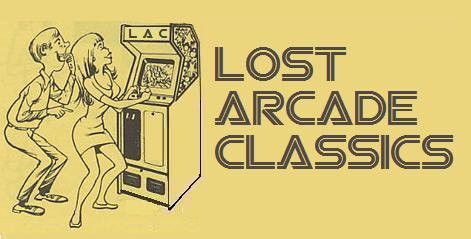

August Nineteenth. On that date in 1934, in Dayton, Ohio, the first All-American Soap Box Derby was held. On that same date in 1960, the Soviet Union launched Sputnik 5, the first satellite to send animals into orbit and bring them home safely, and Leonard Bernstein conducted his final concert on August 19th 1990.
But something else very important occurred on that date just this past year. Ignored by the mainstream media, it in fact received virtually no press at all. Frankly, this is a crying shame as this event could prove to be a defining moment of our times. What happened? The first playable version of a laserdisc game was released in MAME version 0.127. MAME of course, is the pre-eminent arcade machine emulator, and that historical laser disc game, and this issue’s Lost Arcade Classic, is Simutrek’s 1984 stunner, Cube Quest.
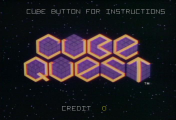 Cube Quest invites the player to conduct an abstract outer space adventure, traveling through the corridors of a gigantic space cube in order to gain the “Treasure of Mytha”, all the while avoiding and destroying enemy forces.
Cube Quest invites the player to conduct an abstract outer space adventure, traveling through the corridors of a gigantic space cube in order to gain the “Treasure of Mytha”, all the while avoiding and destroying enemy forces.
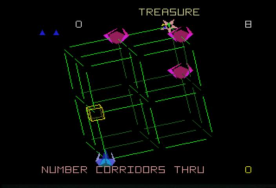 The game begins by displaying a wire-frame map of a cube with four facets per side. From a random starting position, the player selects a heading, and then flies his spaceship through corridors on the edges of the cube facets in order to advance toward the mystical treasure. During this sequence, the scene shifts to a third person view, as the spaceship encounters various enemies and psychedelic imagery in the corridor. Once the spaceship clears a corridor, the map screen returns, showing the player one cube facet closer to the prize, if he chose his heading well, of course. Another heading is then selected, another tunnel traversed, and the game continues until the player reaches the Treasure of Mytha or exhausts all of his reserve ships.
The game begins by displaying a wire-frame map of a cube with four facets per side. From a random starting position, the player selects a heading, and then flies his spaceship through corridors on the edges of the cube facets in order to advance toward the mystical treasure. During this sequence, the scene shifts to a third person view, as the spaceship encounters various enemies and psychedelic imagery in the corridor. Once the spaceship clears a corridor, the map screen returns, showing the player one cube facet closer to the prize, if he chose his heading well, of course. Another heading is then selected, another tunnel traversed, and the game continues until the player reaches the Treasure of Mytha or exhausts all of his reserve ships.
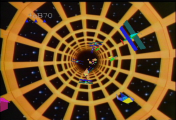 Each corridor features its own swarm of host enemies, which appear as abstractions on real-world objects like pinwheels, tulips, dragonflies, flying fish, western sheriff badges, biplanes and little red helicopters. Periodically a ship identified as a “bonus object” appears with a low droning siren. Nailing it awards 1000 extra points. Regular enemies award 200 or 300 points, depending upon how close they are to your ship when blasted.
Each corridor features its own swarm of host enemies, which appear as abstractions on real-world objects like pinwheels, tulips, dragonflies, flying fish, western sheriff badges, biplanes and little red helicopters. Periodically a ship identified as a “bonus object” appears with a low droning siren. Nailing it awards 1000 extra points. Regular enemies award 200 or 300 points, depending upon how close they are to your ship when blasted.
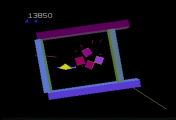 Every few stages, there’s a cosmic obstacle course consisting of sliding “window panes”, folding multi-colored planks, and tumbling cubes, which create and close off gaps that your ship must pass through in order to survive. Successfully clearing any of these obstacles awards 500 points to your score. The spaceship’s missiles are disabled on this screen, so navigation can be the player’s ultimate focus.
Every few stages, there’s a cosmic obstacle course consisting of sliding “window panes”, folding multi-colored planks, and tumbling cubes, which create and close off gaps that your ship must pass through in order to survive. Successfully clearing any of these obstacles awards 500 points to your score. The spaceship’s missiles are disabled on this screen, so navigation can be the player’s ultimate focus.
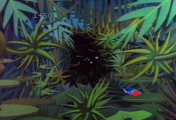 Luckily, Cube Quest is quite generous with bonuses. The player gets 1000 points for surviving each corridor, then on top of that, an additional 5000 point bonus every time five corridors are successfully traversed, and if that wasn’t enough… an extra reserve ship is awarded at each 25,000 point threshold. It quickly becomes apparent that the bonuses are as integral a part of game strategy and longevity as are evasive maneuvering and rapid-fire fingers.
Luckily, Cube Quest is quite generous with bonuses. The player gets 1000 points for surviving each corridor, then on top of that, an additional 5000 point bonus every time five corridors are successfully traversed, and if that wasn’t enough… an extra reserve ship is awarded at each 25,000 point threshold. It quickly becomes apparent that the bonuses are as integral a part of game strategy and longevity as are evasive maneuvering and rapid-fire fingers.
Back on the map screen, several red cubes with purple wings known as the “Guardian Cubes”, travel across the facets in an effort to block your path to the treasure. Selecting a heading toward a Guardian Cube means that after traveling through the corridor, you will battle it in a “boss round” that bears a strong resemblance to the 1980 Cinematronics’ classic Star Castle. The Guardian Cube rotates in the center of the screen, surrounded by multiple concentrically rotating segmented rings. The segments can be blasted as long as they are in orbit around the cube, but once they reach the outer ring, they launch at the player in deadly 3-D. Once launched, they can only be avoided, not destroyed. The cube regenerates rings when all segments in any particular ring are destroyed, and it also sporadically fires missiles at the player’s ship.
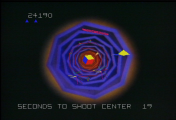 The cube weakens when the bulk of the segments are destroyed before regeneration, causing the color to drain from the cube, and reducing its ability to fire missiles. Blasting the last few ring segments causes the cube to shatter in a stellar explosion sequence, and 5000 additional points are added to the player’s score. The player then returns to the map to plot further progress toward the treasure.
The cube weakens when the bulk of the segments are destroyed before regeneration, causing the color to drain from the cube, and reducing its ability to fire missiles. Blasting the last few ring segments causes the cube to shatter in a stellar explosion sequence, and 5000 additional points are added to the player’s score. The player then returns to the map to plot further progress toward the treasure.
If the player reaches the treasure on the map screen, survives the corridor and defeats the awaiting Guardian Cube, the laserdisc displays a sequence of the player’s spaceship (beginning as a squadron of five which merge into one single ship) traveling through the cosmos, encountering the cube, flying over its surface, and oddly enough, eventually flying into a Cube Quest machine itself. This is the only part of the game that disappointed me. You see, the same exact sequence can be viewed during the attract mode, so it’s rather anti-climatic to see it again after reaching the treasure, the very point to the game itself! There doesn’t appear to be any unique game graphics or laserdisc images related to the Treasure of Mytha itself, although I suppose it is possible that some other game variable (perhaps a score threshold?) “unlocks” a Treasure of Mytha sequence. But this is just conjecture on my part.
Cube Quest feels like the next step in the evolution of tube-shooters originating with Tempest and continuing on through Gyruss. As in these two classics, the enemies emerge from the center of the screen and scale larger as they approach the player’s ship. Unlike these titles, the player’s ship is not locked into a fixed pattern of movement. In fact, I also see a little influence from Atari’s Star Wars, as the player’s ship can be moved anywhere on the screen, much like the crosshairs of the X-wing fighter.
A trak-ball controls the player’s ship, resulting in exceptionally smooth and fluid movement. A fire button is positioned to either side of the trak-ball, for “lefties” and “righties”, and a diamond shaped button (actually a standard square button mounted at an angle so as to appear as a diamond) is located above the trak-ball. This is the “rotate cube” button, which randomly moves the plane that your spaceship is on while on the map screen. It’s an interesting gimmick, because the rotating plane may end up positioning you much closer to the treasure (bypassing some Guardian cubes along the way), or it may move you farther away. The player has no control in what direction the plane will rotate, and it can only be used once per map screen visit. Due to the uncertain results, I tend to use the feature only sporadically.
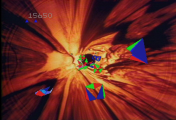 Now let’s turn our attention the real star of the game, the laserdisc visuals, which are used to create the tunnels that the player’s ship travels through. The sales flyer claims fifty-four different backdrop images exist, and although I haven’t seen all of them, I’ve seen images as diverse as volcanic tunnels, jungle foliage, rock caverns, whimsical champagne bubbles, tilting hotel hallways, flying ghostly skulls, Tron-like circuit boards (which is no coincidence, as you’ll read later…), formulas from DaVinci’s notebooks, and swarms of ominous snakes & lizards, bearing their fangs at the player in anger. Each tunnel provides a new and mesmerizing image to distract and delight the player.
Now let’s turn our attention the real star of the game, the laserdisc visuals, which are used to create the tunnels that the player’s ship travels through. The sales flyer claims fifty-four different backdrop images exist, and although I haven’t seen all of them, I’ve seen images as diverse as volcanic tunnels, jungle foliage, rock caverns, whimsical champagne bubbles, tilting hotel hallways, flying ghostly skulls, Tron-like circuit boards (which is no coincidence, as you’ll read later…), formulas from DaVinci’s notebooks, and swarms of ominous snakes & lizards, bearing their fangs at the player in anger. Each tunnel provides a new and mesmerizing image to distract and delight the player.
The player’s ship, enemies, Guardian Cubes and rings, remaining lives, and score table, are standard computer generated graphics overlaid on the laserdisc’s images. A similar effect was used in games like Gottlieb’s MACH 3, Data East’s Bega’s Battle, and Midway’s Astron Belt, among others, and like those titles, the Cube Quest player never actually interacts with the laserdisc backdrop.
Cube Quest’s outstanding laserdisc visuals were the creation of Robert Abel and Associates, a famous and award-winning production firm that specialized in computer-animated effects. RA&A’s groundbreaking work was enjoyed in motion pictures including Tron, and Disney’s The Black Hole, in addition to several brilliant “photo-fusion” style TV commercials for products and companies like 7-Up, Jovan cologne, Levi’s jeans, Dow Scrubbing Bubbles, and AT&T. They also created the opening sequence to Steven Speilberg’s “Amazing Stories” series, ident animation for Columbia Pictures and ABC, and the effects in the music video for the Jacksons’ 1980 hit single “Can You Feel It”. Quite the impressive resume to be sure! RA&A’s work is characterized by fluid animation, bright colors, and sharp definition, and the laserdisc imagery of Cube Quest is no exception to their already high standards of quality.
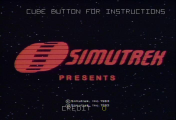 Even the attract mode is noteworthy, as it plays like a motion picture trailer. It begins with an ominous series of descending notes as the Simutrek logo swirls on the screen, fades out, and is replaced with a group of tumbling wire frame cubes, spelling out CUBE QUEST via the highlighted edges of their faces.
Even the attract mode is noteworthy, as it plays like a motion picture trailer. It begins with an ominous series of descending notes as the Simutrek logo swirls on the screen, fades out, and is replaced with a group of tumbling wire frame cubes, spelling out CUBE QUEST via the highlighted edges of their faces.
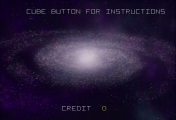 Images of galaxies and spaceships display from the laserdisc as a deep voiced narrator (Ken Nordine of the Word Jazz albums) explains the game’s backstory. Apparently, following 2007, and “The War of Six Planets” (another awesome game “prediction” that didn’t come to pass), mankind has enjoyed centuries of peace. This peace led to a period of space exploration in which “out there… beyond the black holes… near the absolute edge of the possible…the cube was found.”
Images of galaxies and spaceships display from the laserdisc as a deep voiced narrator (Ken Nordine of the Word Jazz albums) explains the game’s backstory. Apparently, following 2007, and “The War of Six Planets” (another awesome game “prediction” that didn’t come to pass), mankind has enjoyed centuries of peace. This peace led to a period of space exploration in which “out there… beyond the black holes… near the absolute edge of the possible…the cube was found.”
He goes on to say that “we’ve all played the cube from the outside… and that was easy”, drawing an amusing parallel to the Rubik’s Cube craze. A question is then postulated… “But how to play it on the INSIDE ? Inside things aren’t so simple. Every corridor leads to the unexpected… to a different brand of doom.” He continues by stating the goal is to attain the treasure by outwitting Mytha and “his cunning army, the Dwellers of the Dark”. The narration ends with a tag-line worthy of a sci-fi movie blockbuster: “Enter the cube. Survive the unthinkable”.
Cube Quest’s cabinet is quite unique as well. It’s largely jet black, and very futuristically styled, with thick red accent lines and virtually no cabinet art to speak of, save for the Cube Quest logo and cube images on the marquee, projecting a minimalist and appropriately “sci-fi” image. Plus, it has a SEAT. Yes, this cabinet is a quasi-cockpit game, featuring an adjustable seat that the player can sit on or lean against, while resting their feet to either side of the coin door.
By the time of Cube Quest’s release in December 1983, operators had been complaining for several months about the unreliability of laserdisc games like Dragon’s Lair and MACH 3. The disc players installed in these machines were designed for home use, and were never intended to be operated in an “industrial capacity” every day for eight plus hours in a commercial setting.
This constant wear and tear caused disc players to break down, rendering machines unplayable, and thus, eliminating earnings potential for the arcade operator. Learning from this design flaw, Simutrek designed Cube Quest so that if the disc player malfunctions, the operator can set the game to run with no background disc images, eliminating downtime for the operator.
Playing the game without the laserdisc background reduces most of the game’s visual allure, but some screens actually end up being easier. The enemy ships and their missiles tend to blend into certain corridors, so with no disc visuals, the enemies stand out better. Or maybe that’s just my color blindness affecting my opinion here.
Cube Quest is a tremendous game with kinetic and frantic gameplay, atmospheric audio, a cabinet that was certainly ahead of its time, and mesmerizing special effects. This is even more impressive when you consider that it was the first and only game created by Simutrek, instead of an established player like Atari, Midway, or Sega.
An interesting side note… For many years, I’ve heard, read, and fully accepted that Atari’s I, Robot was the first arcade video game to feature 3-D polygonal graphics. However, Cube Quest’s spaceships, enemies, and Guardian Cubes were also created via polygons, and Replay Magazine places Cube Quest’s release a full six months prior to I, Robots release date of June ’84!
I assume that Atari demo’d I,Robot sometime in 1983, perhaps at an AMOA show or a test market arcade. Atari then probably returned the game to the lab for additional work before release, during which, Simutrek released Cube Quest. This would technically make I,Robot the first game with polygon graphics, even if it wasn’t the first actually released to arcades. Until the release schedules of Atari and Simutrek can be reconciled, I imagine this will remain a mystery as lasting as the origins of Mytha and cube itself.
Footage of Cube Quest in its “natural environment” (or should I say “in captivity”?) can be viewed on JM Productions’ Starcade.tv website, the online repository for all things related to the 1980’s video arcade game show, Starcade. Look for episode #102, featuring host Geoff Edwards, and contestants Fritz Kubacky and Mitch Harmon.
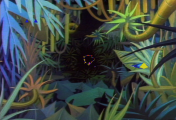 So, will the release of Cube Quest in MAME become one of the “August 19th club” of historical and important events, joining the first All-American Soap Box derby, the launch of Sputnik 5, and Leonard Bernstein’s final concert? Among our arcade collecting community, it certainly should. And if it doesn’t, you can rest assured that Cube Quest, the treasure of Mytha, Ken Nordine’s ominous narration, and Robert Abel and Associates’ vivid visuals will forever have a reserved spotlight, in the museum of the Lost Arcade Classic.
So, will the release of Cube Quest in MAME become one of the “August 19th club” of historical and important events, joining the first All-American Soap Box derby, the launch of Sputnik 5, and Leonard Bernstein’s final concert? Among our arcade collecting community, it certainly should. And if it doesn’t, you can rest assured that Cube Quest, the treasure of Mytha, Ken Nordine’s ominous narration, and Robert Abel and Associates’ vivid visuals will forever have a reserved spotlight, in the museum of the Lost Arcade Classic.